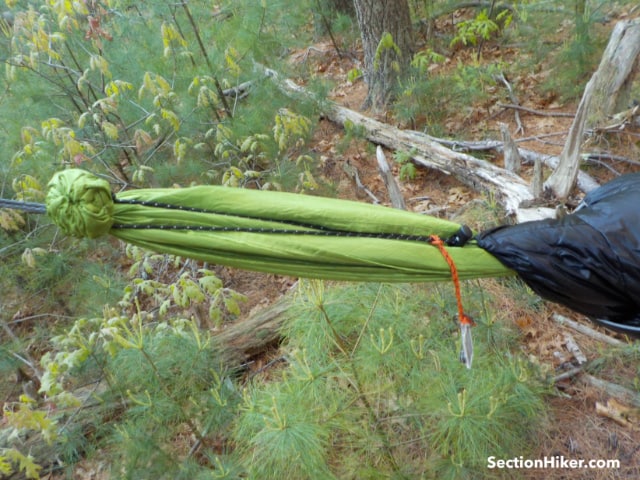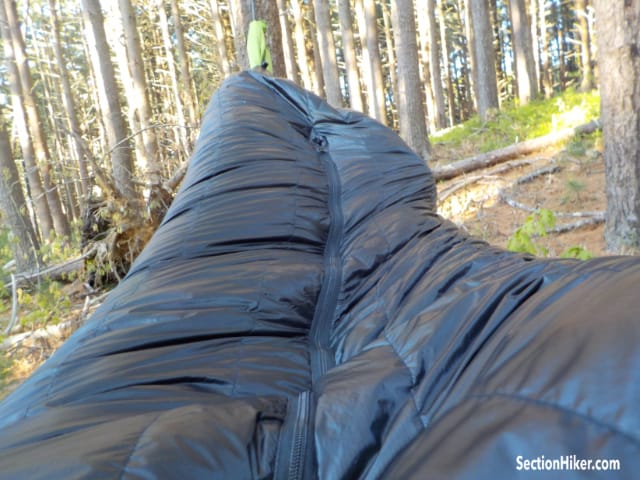The Hyke & Byke Antero 15 is a hybrid ground sleeping bag and hammock peapod insulation system meant to lower the cost of entry into outdoor recreation. I recently reviewed another hammock peapod system, the Outdoor Vitals MummyPod. The Hyke and Byke Antero 15 is a similar concept but it is executed quite differently.
Hyke & Byke Antero 15 Sleeping Bag and Hammock Peapod
Ease of Use
Warmth
Weight
Features
Versatility
What’s a Peapod? Just like your underside needs a pad for insulation when sleeping on the ground, when you’re in a hammock you also need insulation underneath you. Most hammock users hang a 3/4- to full-length underquilt for bottom insulation. Another method is the peapod. It’s pretty easy to see how it got that name. The peapod idea was most notably brought to market by Ed Speer of Speer Hammocks. It’s a great concept, but it can be hard to pull off successfully.

Specification Inaccuracies and Inconsistencies
Unfortunately, Hyke & Byke has a problem with the accuracy and consistency of their specifications. That set off alarm bells with me, since consumers, especially people new to backpacking or camping, need accurate and clear product specs to help them understand the suitability, safety, and value of sleep insulation gear. I can’t tell whether the information inconsistencies are deliberately meant to make the bag seem more competitive or if they come from inexperience and growing pains. But I have engaged extensively with their customer service agents and the specification inaccuracies persist.
To give you a taste of the issues involved, here’s a subset of the misleading specs that I found.
Temperature Rating
The Antero is described as a 15*F bag, but it is nowhere close to that.
Most people buy a sleeping bag rated for the temperatures they expect to experience. While the bag is sold as a 15*F bag, looking carefully at the specs sheet shows that this is actually the Extreme/ Survival rating. The Limit rating is 30*F and the Comfort rating is 50*F–a far cry from 15*F! The Limit Rating is the minimum temp at which an average man will be warm and the comfort is the average temp at which an average woman will be comfortably warm. These two ratings are what one should really look at for a bag rating, and are on a spectrum dependent on the user’s body type, metabolism, caloric reserves, etc.
Hyke & Byke’s sleeping bags are rated in accordance with the International Organization for Standardization (ISO) 23537 standard testing protocol, the 2017 update to EN temperature ratings, which is a good thing, but the decision to name the bags by their Extreme/Survival rating is a problem. The ISO describes the Extreme/Survival rating like this: “In this range, a strong sensation of cold has to be expected. There is risk of health damage by hypothermia. A sleeping bag should only be used in this range in an emergency.”

Insulation fill type and weight
Hyke & Byke’s website lists the Antero 15’s fill weight at 710 grams (25 ounces).
- The product tag lists the insulation type as 90/10 800FP Goose Down.
- The Hyke and Byke website also lists the insulation type as 90/10 800FP Goose Down but adds “LofTech base powered by Allied,” under the category of shell fabric/base.
- On their Amazon page, Hyke & Byke says, “Our quest for the perfect solution led us to utilize Hydrophobic 800 FP Goose Down on top and Allied’s revolutionary LofTech Summit on bottom where down isn’t necessary. LofTech performs better than down for durability under compression and moisture resistance and it has been called ‘the closest synthetic insulation to natural down ever developed’ by the Outdoor Industry Association.”
That would mean the Antero 15 is a hybrid down/ synthetic bag, not a goose down sleeping bag as stated on the product tag, which is the only thing that would make the fill weight make sense because the bag is nowhere near as warm as other bags with this fill weight.
Product Performance
So how does the product perform if it’s more accurately described as a 30 degree, hybrid down/synthetic sleeping bag and peapod system?
Temperature Rating
The Antero bag has kept me warm down to 40 degrees for ground and peapod use, but I wouldn’t want to take in much lower than that. I’m on the short side and fairly lean, so I probably sleep a bit colder than taller or heavier adults males. In the absence of sleeping bag temperature testing equipment, I’d say that a 30 degree Lower Rating is realistic.

I appreciate the fact that Hyke & Byke tested the temperature rating of the Antero using the ISO temperature rating standard. I just wished they’d advertised the Antero with a Lower Limit Rating 30*F, which is the norm used by the rest of the outdoor industry, instead of the Extreme Limit Rating of 15*F. That is confusing.
Attachment to a hammock
The Antero attaches to the hammock via two drawstring tubes–one at the head end and one at the foot end–that cinch closed with a cordlock. This system is simple, intuitive and allows for the hood to have a snug fit around the head and face which is great for locking in warmth. There is no additional suspension system holding the bag in place beyond these drawstring tubes.
The Antero uses static (non-elastic) cord for all its drawstrings–at the foot end, the head end, and around the face. However, hammocking is not a static activity–any movement in a hammock causes sway, and the trees themselves can sway in the wind. As the closures have no natural give with your movement, the only thing that can give is for the cordlocks to slide up their cords under pressure, loosening the openings. This causes the ends of the hammock to slide down the hammock towards the middle, dropping the insulation away from the underside of your body, which happened to me the first night I used the bag in hammock mode.

I searched online to see if anyone else had this problem, and one reviewer on Amazon suggested clipping the drawcords to the carabiners which attach the hammock to its suspension. My suspension system doesn’t use carabiners, so I cinched up the cordlocks on either end of the bag and slipped the cord loop over the gathered ends of my hammock. This worked well to keep the bag suspended in place but was still a static system that felt tight and restrictive. The peapod system would be vastly improved if the drawcords were replaced with shockcord.
I did appreciate that the bag’s girth and shape allowed me to get a slight diagonal lay in the hammock which is often difficult to do with peapod systems.
Shell Fabric
The shell fabric, in black, has a plasticky-looking finish, and this shiny DWR coating is effective at shedding water. I experienced this firsthand in a leaky shelter.
Hyke & Byke offers a number of bright color combinations between the shell and liner. The liner is super soft and silky, the most comfortable lining fabric I’ve ever experienced in a sleeping bag. But when I asked Hyke and Byke’s customer service for more information about it, I was told that its a cotton blend. If true, that is a red flag. Cotton is not a fabric meant for the outdoors in any inclement conditions because it’s too difficult to dry with body heat, especially on the inside of a sleeping bag.

Anti-snag YKK zipper
I was actually able to snag the fabric of the Antero in its anti-snag zipper. There is grosgrain ribbon acting as a stiffener under one side of the zipper but not the other, and the thin fabric of the other side would occasionally get caught in the zipper teeth when zipping rapidly.
Despite this, the center zipper does make it easy to get in and out of the Antero at night, especially when used with a hammock.
Pockets
Pockets on sleeping bags are very handy to keep batteries from freezing and your headlamp close at hand. The Antero has long (but shallow) puffy pockets on the inside of the bag, with an integrated security pocket closed with no-snag velcro on the right-hand side. These pockets act kind of like a chest baffle, filling some of the dead-air space between the user and the top of the bag when in hammock peapod mode, but their utility as pockets is limited.
I put my phone, camera, and headlamp in the main pockets and my keys in the velcro pocket. The heavier items sagged in the pocket and rested on my chest. Three out of the four items fell out on top of me in the night–including the keys in the “security” pocket. Only the headlamp remained in place, down in the corner of the pocket close to my ribs.

Qualified Recommendation
The Hyke & Byke Antero 15 is a very viable peapod insulation setup if you’re looking for all-in-one hammock insulation system that is simpler to use than a top quilt/underquilt combo and a lot less fiddly. You’ll still want to replace the static cord with shockcord, as I describe above, but the Antero isn’t bad value for $200, provided that you don’t try to take it below its 30-degree Lower Limit rating in the air or on the ground.
Likes:
- Super comfortable liner fabric
- Water-resistant shell fabric
- Design that keeps the benefits of a mummy bag (head warmth) while in hammock mode
- Comfortable placement of face drawcord cordlock (off to one side) and use of a soft chin guard for the zipper
- The shape of the bag allows for a slight diagonal lay in hammock mode
Room for improvement:
- Clarify the bag’s true specs and materials across all platforms
- Replace static cords (around the face and on both ends) with elastic shock cords
- Name sleeping bags according to real-use temperatures, not extreme/survival ratings
- Bigger stuff sack and/or a more robust material
- Redesign interior pockets so contents don’t fall out.
About the Author
Compare 1 Prices
Disclosure: Hyke & Byke provided SectionHiker with a sample Antero 15 for this review.
SectionHiker is reader-supported. We only make money if you purchase a product through our affiliate links. Help us continue to test and write unsponsored and independent gear reviews, beginner FAQs, and free hiking guides. SectionHiker.com Backpacking Gear Reviews and FAQs
SectionHiker.com Backpacking Gear Reviews and FAQs 


Greg,
Thank you for the honest, detailed appraisal.
You’re welcome, Grandpa!
Hi. Thanks for the review. I didn’t see a weight listed for the whole thing kisted. Was it close to what is listed from the company?
Sorry for my late reply, Ray, and thanks for your question. As I weighed the Antero on my scale it came in at a weight of 38.7 ounces plus 2.3 ounces for the stuff sack. Hyke and Byke’s website lists the “total pack weight” as 2.87 pounds (45.92 ounces) which likely includes the stuff sack. So my measurements came well _under_ the stated weight which raises questions of standardization, especially of the amount of fill used.
Back in the 1970s, before much variation in cubic inch “fill power ” was advertised, it was sometimes said that X pounds of down would result in Y temperature ratings. (I think it was two and a half pounds was good for zero degrees F, but not sure.) If H&B fudges this, that’d be good to know.
PS–the formula, whatever it was, I probably read in an early edition of Fletcher, and applied to generic mummy designs.
Sorry. Formula was Xpounds fill = Y temperature ratings.
Hyke and Byke is a sham company with garbage products. Bought Shamano for my son’s thru hike on the AT. It lasted about a month and a half before a hole developed on the inside around the elbow area.
He always slept on a pad. H&B refused warranty calling it normal wear and tear. Don’t be fooled by their nice web site like I was!
Greg are there any other similar bags that you might recommend before this bag
Hi Matthew, unfortunately, I haven’t found a peapod system I’m really excited about. Check out our review of the Outdoor Vitals Mummy Pod for a bit more info on peapods; one thing to consider with peapods is that you often need an extra top quilt layer to fill the dead air space that’s created by a peapod’s tight fit around the hammock as opposed to around your body. I really liked the idea when I first saw it, as it seemed much simpler with less moving parts than the standard hammock setup. But the improved comfort of a separate top quilt and underquilt, for me, outweighs the seeming convenience of a peapod system. I just hammocked last weekend in temps that were zero*F or a little lower, with two 30*F underquilts stacked on each other and a 10*F topquilt, with a 55*F summer quilt wrapped around my feet, all enclosed in a winter sock covering top and bottom. That’s a ton of insulation to carry (4 quilts!) but I was able to get a full diagonal lay and move from my back to my side in the night with no problem. I was comfy and warm.
Bought this, very excited that someone even made anything like this. Bought it in October (too cold for use where I live), but everything looked good. Set it up on the shelf for the upcoming season that I could use it. Pulled it off the shelf early, thinking I could utilize it with a hammock quilt I purchased. Set it up and froze my butt off! Literally, the under side of the bag has near ZERO insulation. Attempting to move the fill around to spread it out, I was confused why I couldn’t get it spread. Using a light to back-light the area, I discovered the issue… The baffles in where your butt goes, had nothing in them. And they were cut off (as far as I could tell with the back-light) from other baffles that I could have spread it out with.
It was brand new. Never used (except for the few minutes spent that night out in the cold. Because of how I chose to stick it on the shelf for a few months rather than do a thorough inspection, I knew I wouldn’t be able to utilize their return policy. But I was confident that this was a manufacturing issue.
But to my utter and complete surprise, they denied it. Don’t do it! They do’t care about what is right or wrong and will just take your money.
If you bought it with a credit card, open a dispute with your credit cart company. That’ll get their attention.